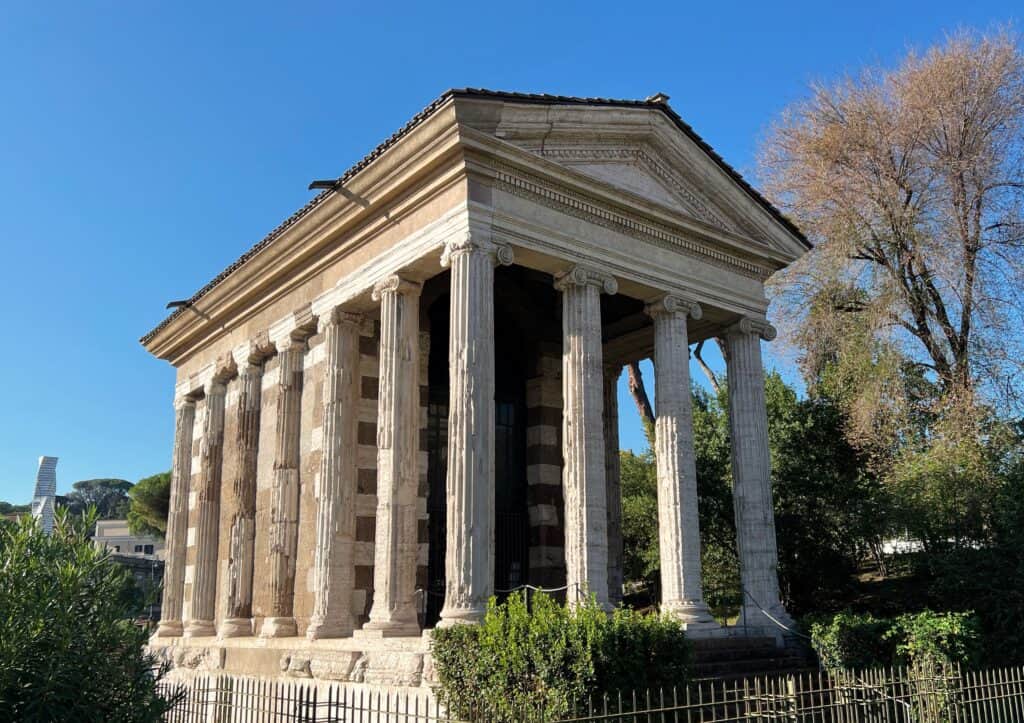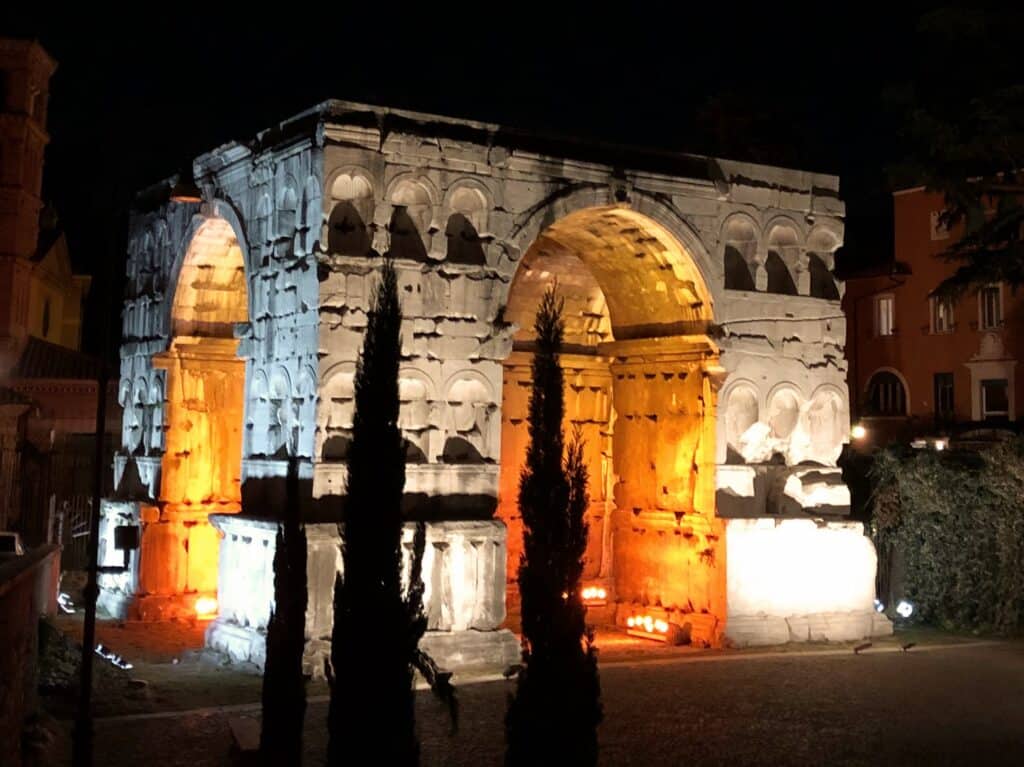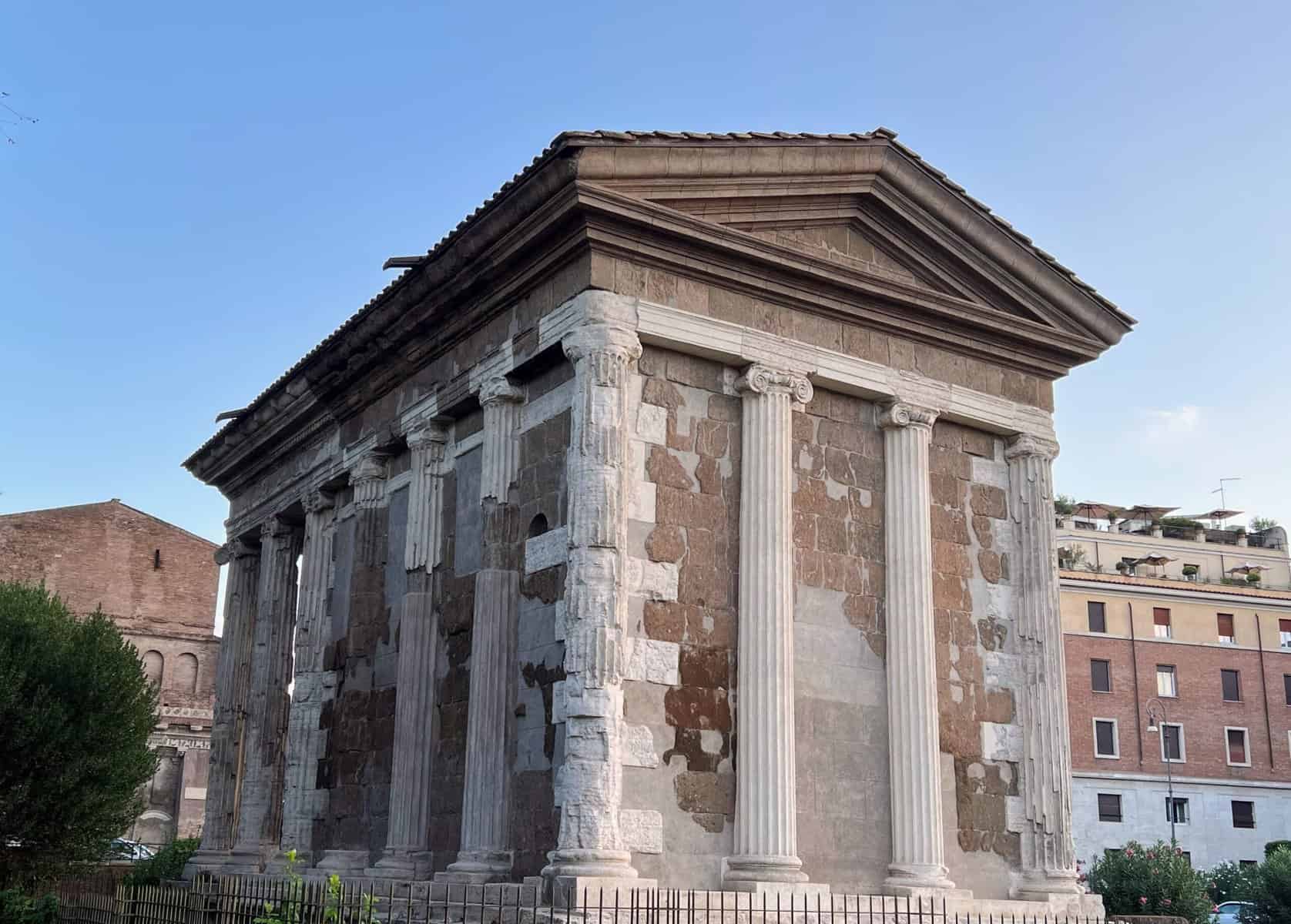The Forum Boarium, Rome’s Ancient Cattle Market
When thinking about ancient Rome, cattle markets generally don’t spring to mind. Then again, the Forum Boarium was never just about cows; gods and gladiators joined merchants as regulars around Rome’s original port. While its buildings may not have been the city’s largest or most opulent, they survived better than most. The compact site features two intact temples, a monumental four-way arch, and remnants of Rome’s oldest stone bridge.
The Forum Boarium is free to visit any time and never gets crowded. It sits at the foot of the Palatine Bridge, between Tiber Island and the Circus Maximus. Across the street, busloads of tourists line up to see the Mouth of Truth, all of them seemingly unaware of one of the city’s most fascinating spots.
All sites are marked on our Google map.
Ancient Rome’s Port and Cattle Market
Rome’s first set of docks, the Portus Tiberius, clustered around a flat area where the Capitoline, Palatine, and Aventine hills meet. The surrounding site grew into the Forum Boarium (Foro Boario), a thriving market area where cattle and other goods entered the city. Trading activities prompted the construction of temples where merchants could seek the gods’ blessing.

Some forms of worship included sacrificing animals – and, on one grisly occasion, possibly even humans. According to the ancient historian Livy, in 215 BCE the Romans buried four victims alive at the Forum Boarium in a desperate attempt to placate the gods.
Hercules and the First Gladiator Contests
Cult worship of Hercules developed in the Forum Boarium. In the Aeneid, Virgil describes the demigod killing a giant near the Aventine hill, then setting up an altar on the spot where the locals could show their gratitude. The original Ara Maxima, or Great Altar, was destroyed during the fire of 64 CE; its replacement vanished from recorded history several centuries later.
A platform identified as the foundation of the Great Altar lies in the crypt of the Santa Maria in Cosmedin church (across the street from the main forum). The chunk of stone dates to the fifth or sixth century BCE but looks unremarkable – we definitely needed the sign to find it!


Santa Maria in Cosmedin (left), where the monumental gilded sculpture of Hercules (right) was found. Excavated at the end of the fifteenth century, the statue may have inspired Michelangelo’s David.
Two ancient statues of Hercules have been found on the site: a gilded bronze of ancient Greek proportions, now in the Capitoline’s Palazzo dei Conservatori and a burly, heavily-restored marble rendition in the Palazzo Altemps.
Besides making sacrifices at the altar, Romans honored Hercules by staging contests of strength and prowess. In 264 BCE, a wooden arena at the Forum Boarium held the city’s first gladiatorial contest.
Temple of Hercules Victor

The two thousand year old Temple of Hercules Victor is a monument to Rome’s Republican years – before the megalomaniac emperors – and a tribute to the refinement of Greek culture. In a city where pomp and grandeur reigned supreme, this little building holds its own by virtue of its elegant lines. It’s also remained remarkably intact, even compared to Roman structures built hundreds of years later.

The temple’s origins are debated, though one theory links it with second-century BCE general Lucius Mummius Achaicus, who conquered much of Greece. Other than its circular form, the temple’s most distinctive aspect is its pure Greek style, right down to its walls of solid marble imported from Attica. Most structures in Rome adapted Hellenistic architecture rather than copying it outright, especially when it came to using stone. Pragmatic Romans preferred to build with lightweight, locally-available materials like volcanic tufa and brick, limiting marble to a thin layer on top. The unusual and extravagant all-marble construction of the Temple of Hercules required labor-intensive carving for each and every piece.
For more information, see our post Temple of Hercules Victor: The Oldest Building in Rome.
Temple of Portunus
The Temple of Portunus dates to around 100 BCE. Like its round neighbor, the temple’s original dedication is uncertain and it once went by a different name – in this case, the rather suggestive Fortuna Virilis, or Manly Fortune. Given its location by the docks, scholars now associate the temple with Portunus, the god of ports, gateways, and livestock. Merchants could make last-minute offerings for their outgoing merchandise, while incoming products could be conveniently blessed en route.

Thanks to its conversion into a church in 872, the structure escaped being looted for building materials. Like most Roman temples, it follows the Greek model of a rectangular cella holding the god’s statue, surrounded by a colonnaded walkway. In an interesting variation, the Portunus features an enlarged interior, with the side and rear columns halfway embedded in the walls. The layout preserves the illusion of an arcade within a smaller footprint, and would serve as the model for the Maison Carrée in Nîmes. Like the Temple of Hercules, the Portunus inspired Palladio and other Renaissance architects.
Aemilian or Rotten Bridge
On the other side of the forum lies one of the city’s stranger sights: a massive, ancient arch in the middle of the river. The Ponte Rotto (“Broken Bridge”) is all that remains of the Pons Aemilius, a triple-arch bridge constructed in the second century BCE and coinciding with the erection of the Temple of Hercules.


A 1598 flood washed away one of the original arches, while another was removed to make room for the Palatine Bridge, leaving the center all alone.
For more information, see our guide to Rome’s bridges.
Arch of Janus

Rome’s only quadrifrons, or four-sided arch, is one of the city’s most curious structures. It’s scaled like an enormous triumphal arch, but no one has been able to decipher why it was built. The core of brick and pottery shards was covered with spolia (marble recycled from other buildings) during Constantine’s reign in the early fourth century. Contrary to popular belief, the Emperor continued constructing pagan monuments after his conversion to Christianity. Statues which filled the 48 niches have long since disappeared, but some decoration remains on the interior.

The Frangipane family converted the structure into a fortress in the Middle Ages, probably helping to preserve it. During the Renaissance, it became associated with the god Janus who was often depicted with four faces. Janus fits the site nicely since he, like Portunus, was believed to rule doors and gateways. Unfortunately 19th century “conservationists” removed the entire upper section in the belief that it wasn’t original – hence the awkward, truncated appearance today. A car bomb exploded near the arch in 1993, furthering its general decay. Several restoration projects later, it’s unclear when the fence isolating it will be removed.
Nearby
Many consider the Cloaca Maxima, or Great Drain, to be the oldest construction in Rome. One of the world’s earliest sewer systems, it also helped the city expand into the swampy lower areas between the hills. As monuments go, it’s not the most exciting to look at, but the humble arch on the side of the Tiber River has been functioning for over two and a half millennia.


The Mouth of Truth (left) and Casa dei Cresenzi (right)
A massive marble mask depicting the god Oceanus acquired the nickname Bocca della Verità or Mouth of Truth during the Middle Ages. It now sits in the front porch of the Santa Maria in Cosmedin church.
Directly across the street from the Temple of Portunus, the 12th-century Casa dei Cresenzi incorporates fragments of ancient architecture into its walls.
Further Reading

Mary Beard’s SPQR: A History of Ancient Rome gives a concise but thought-provoking context.
For more on ancient Rome, see our posts:
Temple of Hercules Victor: The Oldest Building in Rome
A Guide to Rome’s Ancient and Historic Bridges
Celio: Rome’s Best Neighborhood Hidden in Plain Sight
A Guide to Rome’s Ancient Churches and Basilicas
Historical Fiction Series: Europe From Ancient Rome to the Renaissance

